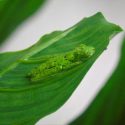
Lemur Leaf Frog Natural History
Size
The Lemur Leaf Frog can grow to between 3-5 cm long with females being slightly larger than males. Females can weigh up to 4g, with males weighing less.
Habitat and Distribution
The nocturnal Lemur Leaf Frog is native to Central America; specifically Costa Rica, Panama and some parts of Colombia. They typically inhabit humid forests and wetlands as they spend their time in water and on the ground, as well as sloping mountainsides.
Age
The lifespan of a Lemur Leaf Frog ranges between 5-10 years old. They are classed as an adult frog between 1.5-2 years old.
Diet
Lemur Leaf Frogs are typically insectivores and eat a range of insects but they also eat other small invertebrates.
Groups and Breeding
Breeding takes place from April to July during the rainy season. Males will call for females near a body of water and a female will then lay 2 or 3 clutches of eggs per night with around 15-20 eggs in each clutch. The eggs are laid on the surface of the water or on the underside of a leaf. The humid environment allows the eggs to develop and 7- 14 days later the rain encourages the larvae to ‘wiggle’ out of the egg and fall into the water below. Like with all frog species, a Lemur leaf frog larvae will transform (metamorphosise) into a tadpole and eventually into an adult frog; this process can take between 69-98 days.
Threats
The Lemur Leaf Frog is often hunted for the international pet trade and is threatened by habitat loss and invasive species. The IUCN Red List classes this species as Critically Endangered.
Interesting Facts
Lemur Leaf Frogs are very territorial and males warn others with a short ticking call when they get too close. Adult Lemur Leaf Frogs can change their colour from a yellow-green to brown at night to blend in with the shadows; they can do this even as tadpoles! These frogs rarely jump and only do so when escaping danger.
The Leaf Frogs During Your Day Out in Kent
Our Lemur Leaf Frogs can be found in our new Reptile House in the designated Frog Room.